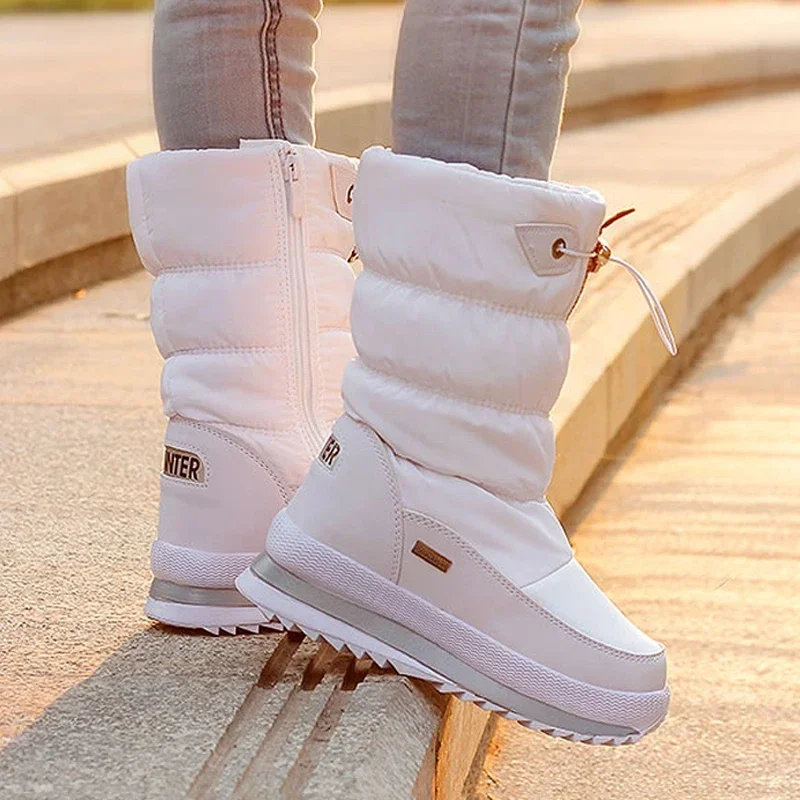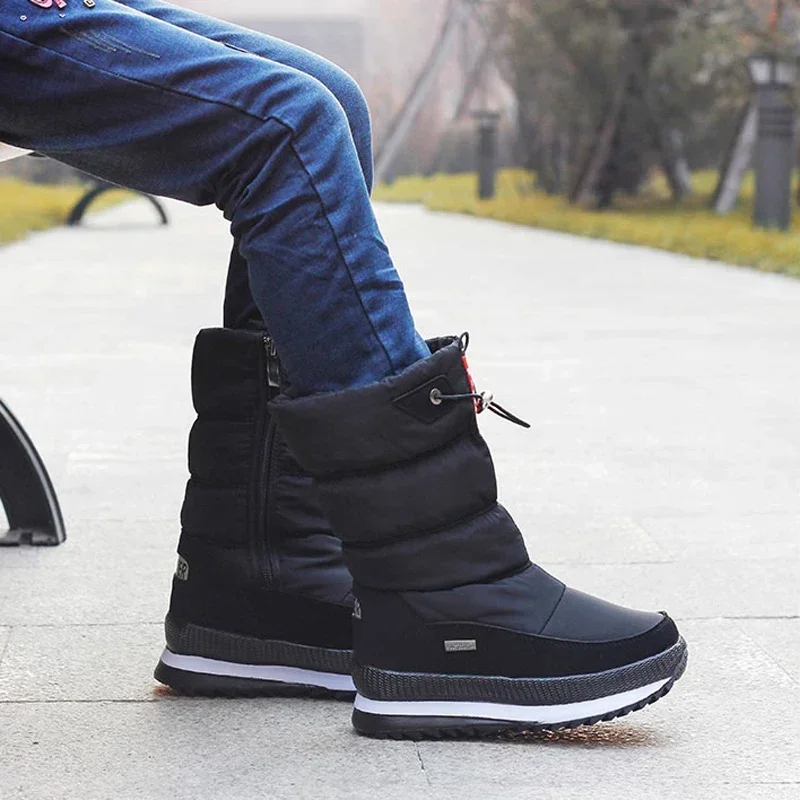Introduction
Winter can be harsh, especially if you live in an area with heavy snowfall or rain. It’s essential to have the right footwear to keep your feet dry and warm. This guide will help you understand the importance of women’s winter boots waterproof, explore different styles and features, and provide tips for choosing the perfect pair.

Why Waterproof Winter Boots Are Essential
Protecting Against the Elements
Winter weather often brings snow, rain, and icy conditions. When you step outside, you need boots that can handle these elements. Waterproof winter boots keep your feet dry, which is crucial for comfort and health. Wet feet can lead to cold toes and, in severe cases, frostbite. Having waterproof boots helps you avoid these dangers.
These boots come with various waterproofing technologies. Many use special materials that repel water. Some brands apply coatings to the outside of the boot. Others use membranes that block moisture while allowing your feet to breathe. This combination keeps your feet warm and dry.
Comfort and Warmth
In addition to being waterproof, winter boots should also provide comfort and warmth. Cold weather can make your feet feel numb and uncomfortable. Insulated boots can help retain heat. Look for boots with materials like Thinsulate or fleece. These materials trap warmth without adding too much bulk.
A good fit is also vital for comfort. Make sure the boots have enough room for thick socks. A snug fit will help prevent blisters. Many brands offer boots with adjustable features. These features allow you to customize the fit.
Features to Look For in Waterproof Winter Boots
Insulation and Breathability
Insulation is a critical feature in winter boots. It helps keep your feet warm in frigid temperatures. Different boots have varying levels of insulation. Some are lightweight, ideal for milder winters. Others are heavily insulated, perfect for extreme conditions.
Breathability is just as important as insulation. Boots that trap moisture can make your feet sweat. Wet feet can lead to cold toes. Look for boots that offer breathability without compromising waterproofing.
Traction and Grip
Winter conditions often mean slippery surfaces. You need boots that provide excellent traction. Look for rubber outsoles with deep treads. These outsoles help you maintain grip on ice and snow. Some brands design outsoles specifically for winter conditions.
Consider boots with features like ice grips or studded soles. These add extra traction when walking on slippery surfaces. If you live in an area with frequent ice, this feature can be a lifesaver.
Weight and Flexibility
The weight of your boots can affect your comfort. Heavy boots can tire your legs and feet quickly. Look for lightweight options that still offer protection and support. Many modern materials provide a good balance between weight and durability.
Flexibility is also important. You want boots that allow for natural movement. Stiff boots can lead to discomfort. Make sure the boots have enough flex to accommodate walking and climbing.

Top Styles of Women’s Waterproof Winter Boots
Ankle Boots
Ankle boots are a popular choice for winter. They provide good coverage without being too bulky. Many ankle boots come with waterproof features, making them suitable for wet conditions.
These boots are versatile and can be styled with various outfits. They can be worn with jeans, leggings, or even dresses. Ankle boots often have insulation to keep your feet warm.
Mid-Calf Boots
Mid-calf boots offer more coverage and warmth. They provide additional protection against snow and cold. These boots usually have thicker insulation, making them ideal for extreme winter conditions.
Many mid-calf boots come with adjustable features. These features help you achieve a snug fit. Look for boots with adjustable straps or laces for a customized fit.
Knee-High Boots
Knee-high boots are perfect for deep snow. They provide excellent coverage and warmth. These boots often have thick insulation and waterproof materials. They can keep your feet warm even in the harshest conditions.
Knee-high boots can be a stylish addition to your winter wardrobe. They can be worn with skirts or over leggings. Many designs come with fashionable details, making them both functional and stylish.
How to Choose the Right Pair of Waterproof Winter Boots
Assess Your Needs
Before you start shopping, assess your needs. Consider your typical winter activities. Will you be walking in the snow? Do you need boots for casual outings or more intense activities? Understanding your requirements will help you narrow down your choices.
Fit and Comfort
Fit is one of the most important factors in choosing winter boots. Ensure there is enough room for thick socks. Your toes should have space to move. Try the boots on with the type of socks you plan to wear. Walk around to check for comfort and support.
Style and Aesthetics
While functionality is crucial, style matters too. You want boots that you’ll enjoy wearing. Look for designs and colors that fit your personal style. Many brands offer a range of styles, from classic to modern.
Price and Quality
Set a budget before you start shopping. Quality boots may cost more but will last longer. Look for brands known for their durability. Read reviews and check ratings to ensure you’re making a wise investment.

Caring for Your Waterproof Winter Boots
Cleaning and Maintenance
Proper care will extend the life of your winter boots. After wearing them, remove dirt and salt. Use a damp cloth to wipe the exterior. For tough stains, use a mild soap.
Avoid soaking your boots in water. Instead, use a gentle brush to clean them. If your boots are leather, consider applying a leather conditioner. This will keep the material supple and prevent cracking.
Waterproofing Treatments
Even waterproof boots need regular treatment. Over time, the waterproofing can wear off. Look for sprays or treatments designed for your boot material. Apply these treatments according to the manufacturer’s instructions.
Reapply waterproofing regularly, especially after heavy use. This will help maintain the boots’ effectiveness against moisture.
Storage Tips
Store your boots in a cool, dry place when not in use. Avoid leaving them in damp areas or direct sunlight. To maintain their shape, use a boot tree or stuff them with newspaper. This helps prevent creasing and damage.
Tips for Winter Boot Selection
Understanding Temperature Ratings
Many winter boots come with temperature ratings indicating the coldest conditions they can withstand. Familiarize yourself with these ratings to choose a boot that meets your climate needs. For example, if you live in a region that often dips below freezing, look for boots rated for sub-zero temperatures.
Try Before You Buy
If possible, visit a store to try on several pairs of boots. Pay attention to the fit around your heel and toe areas. Walk around to ensure they’re comfortable with some movement. Don’t forget to check how they feel when you flex your foot.
Consider Arch Support
Good arch support is essential for comfort, especially if you plan to wear your boots for long periods. Look for boots that offer built-in arch support or consider adding custom insoles if needed. This can help prevent fatigue and discomfort during winter activities.
Conclusion
Choosing the right waterproof winter boots is essential for staying comfortable and dry during the colder months. Consider factors like insulation, traction, and fit when making your decision. With so many styles available, you can find boots that meet your needs and match your style.
Proper care will ensure your boots last for many winters to come. Invest in quality footwear, and enjoy all that winter has to offer without worrying about wet or cold feet.
